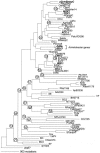Identification of a new allelic variant of the Acinetobacter baumannii cephalosporinase, ADC-7 beta-lactamase: defining a unique family of class C enzymes
- PMID: 15980372
- PMCID: PMC1168656
- DOI: 10.1128/AAC.49.7.2941-2948.2005
Identification of a new allelic variant of the Acinetobacter baumannii cephalosporinase, ADC-7 beta-lactamase: defining a unique family of class C enzymes
Abstract
Acinetobacter spp. are emerging as opportunistic hospital pathogens that demonstrate resistance to many classes of antibiotics. In a metropolitan hospital in Cleveland, a clinical isolate of Acinetobacter baumannii that tested resistant to cefepime and ceftazidime (MIC = 32 microg/ml) was identified. Herein, we sought to determine the molecular basis for the extended-spectrum-cephalosporin resistance. Using analytical isoelectric focusing, a beta-lactamase with a pI of > or = 9.2 was detected. PCR amplification with specific A. baumannii cephalosporinase primers yielded a 1,152-bp product which, when sequenced, identified a novel 383-amino-acid class C enzyme. Expressed in Escherichia coli DH10B, this beta-lactamase demonstrated greater resistance against ceftazidime and cefotaxime than cefepime (4.0 microg/ml versus 0.06 microg/ml). The kinetic characteristics of this beta-lactamase were similar to other cephalosporinases found in Acinetobacter spp. In addition, this cephalosporinase was inhibited by meropenem, imipenem, ertapenem, and sulopenem (K(i) < 40 microM). The amino acid compositions of this novel enzyme and other class C beta-lactamases thus far described for A. baumannii, Acinetobacter genomic species 3, and Oligella urethralis in Europe and South Africa suggest that this cephalosporinase defines a unique family of class C enzymes. We propose a uniform designation for this family of cephalosporinases (Acinetobacter-derived cephalosporinases [ADC]) found in Acinetobacter spp. and identify this enzyme as ADC-7 beta-lactamase. The coalescence of Acinetobacter ampC beta-lactamases into a single common ancestor and the substantial phylogenetic distance separating them from other ampC genes support the logical value of developing a system of nomenclature for these Acinetobacter cephalosporinase genes.
Figures


Similar articles
-
Resistance to oxyimino-cephalosporins conferred by an alternative mechanism of hydrolysis by the Acinetobacter-derived cephalosporinase-33 (ADC-33), a class C β-lactamase present in carbapenem-resistant Acinetobacter baumannii (CRAb).mBio. 2025 Jun 11;16(6):e0028725. doi: 10.1128/mbio.00287-25. Epub 2025 May 16. mBio. 2025. PMID: 40377322 Free PMC article.
-
Extended-spectrum cephalosporinase in Acinetobacter baumannii.Antimicrob Agents Chemother. 2010 Aug;54(8):3484-8. doi: 10.1128/AAC.00050-10. Epub 2010 Jun 14. Antimicrob Agents Chemother. 2010. PMID: 20547808 Free PMC article.
-
Extended-spectrum AmpC cephalosporinase in Acinetobacter baumannii: ADC-56 confers resistance to cefepime.Antimicrob Agents Chemother. 2011 Oct;55(10):4922-5. doi: 10.1128/AAC.00704-11. Epub 2011 Jul 25. Antimicrob Agents Chemother. 2011. PMID: 21788456 Free PMC article.
-
Extended-spectrum cephalosporinases: structure, detection and epidemiology.Future Microbiol. 2007 Jun;2(3):297-307. doi: 10.2217/17460913.2.3.297. Future Microbiol. 2007. PMID: 17661704 Review.
-
Structural and Functional Aspects of Extended-Spectrum AmpC Cephalosporinases.Curr Drug Targets. 2016;17(9):1051-60. doi: 10.2174/1573399811666150615144707. Curr Drug Targets. 2016. PMID: 26073861 Review.
Cited by
-
Genomic analysis of Acinetobacter baumannii A118 by comparison of optical maps: identification of structures related to its susceptibility phenotype.Antimicrob Agents Chemother. 2011 Apr;55(4):1520-6. doi: 10.1128/AAC.01595-10. Epub 2011 Jan 31. Antimicrob Agents Chemother. 2011. PMID: 21282446 Free PMC article.
-
Treatment options for carbapenem-resistant and extensively drug-resistant Acinetobacter baumannii infections.Drugs. 2014 Aug;74(12):1315-33. doi: 10.1007/s40265-014-0267-8. Drugs. 2014. PMID: 25091170 Free PMC article. Review.
-
Antimicrobial resistance in Acinetobacter baumannii: From bench to bedside.World J Clin Cases. 2014 Dec 16;2(12):787-814. doi: 10.12998/wjcc.v2.i12.787. World J Clin Cases. 2014. PMID: 25516853 Free PMC article. Review.
-
Molecular analysis of Acinetobacter baumannii isolates from invasive infections in 2009 in Poland.J Clin Microbiol. 2012 Nov;50(11):3813-5. doi: 10.1128/JCM.02271-12. Epub 2012 Sep 12. J Clin Microbiol. 2012. PMID: 22972816 Free PMC article. No abstract available.
-
Class C β-Lactamases: Molecular Characteristics.Clin Microbiol Rev. 2022 Sep 21;35(3):e0015021. doi: 10.1128/cmr.00150-21. Epub 2022 Apr 18. Clin Microbiol Rev. 2022. PMID: 35435729 Free PMC article. Review.
References
-
- Altschul, S. F., W. Gish, W. Miller, E. W. Myers, and D. J. Lipman. 1990. Basic local alignment search tool. J. Mol. Biol. 215:403-410. - PubMed
-
- Bonomo, R. A., J. Liu, Y. Chen, L. Ng, A. M. Hujer, and V. E. Anderson. 2001. Inactivation of CMY-2 β-lactamase by tazobactam: initial mass spectroscopic characterization. Biochim. Biophys. Acta 1547:196-205. - PubMed
Publication types
MeSH terms
Substances
Associated data
- Actions
Grants and funding
LinkOut - more resources
Full Text Sources
Molecular Biology Databases
Research Materials
Miscellaneous

